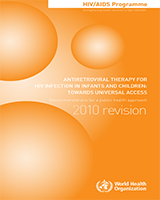All rights reserved. Publications of the World Health Organization can be obtained from WHO Press, World Health Organization, 20 Avenue Appia, 1211 Geneva 27, Switzerland (tel.: +41 22 791 3264; fax: +41 22 791 4857; e-mail: tni.ohw@sredrokoob). Requests for permission to reproduce or translate WHO publications – whether for sale or for noncommercial distribution – should be addressed to WHO Press, at the above address (fax: +41 22 791 4806; e-mail: tni.ohw@snoissimrep).
NCBI Bookshelf. A service of the National Library of Medicine, National Institutes of Health.
Antiretroviral Therapy for HIV Infection in Infants and Children: Towards Universal Access: Recommendations for a Public Health Approach: 2010 Revision. Geneva: World Health Organization; 2010.

Antiretroviral Therapy for HIV Infection in Infants and Children: Towards Universal Access: Recommendations for a Public Health Approach: 2010 Revision.
Show detailsIntroduction
Download PDF (40K)
General principles
Download PDF (39K)
The need for new formulations and new research
Download PDF (47K)
Harmonized dosing schedules
Download PDF (51K)
Drug formulations and dosages
1. Nucleoside reverse transcriptase inhibitors (NRTIs)
1.1. LAMIVUDINE (3TC) (PDF, 52K)
1.2. STAVUDINE (d4T) (PDF, 52K)
1.3. ZIDOVUDINE (AZT OR ZDV) (PDF, 60K)
1.4. ABACAVIR (ABC) (PDF, 55K)
1.5. DIDANOSINE (ddl) (PDF, 61K)
1.6. EMTRICITABINE (FTC) (PDF, 47K)
1.7. TENOFOVIR (TDF) (PDF, 47K)
2. Non-nucleoside reverse transcriptase inhibitors (NNRTIs)
2.1. EFAVIRENZ (EFV) (PDF, 51K)
2.2. NEVIRAPINE (NVP) (PDF, 59K)
2.3. ETRAVIRINE (ETV) (PDF, 53K)
3. Protease inhibitors (PIs)
3.1. SAQUINAVIR (SQV) HGC (PDF, 47K)
3.2. LOPINAVIR/RITONAVIR (LPV/r) (CO-FORMULATION) (PDF, 56K)
3.3. RITONAVIR (RTV) (PDF, 48K)
3.4. DARUNAVIR (DRV) (PDF, 47K)
3.5. ATAZANAVIR (ATV) (PDF, 47K)
4. Fixed-dose combinations (FDCs)
Antiretroviral therapy generally requires the use of three or more drugs. This often requires taking a large number of tablets/capsules each day. Fixed-dose combinations (FDCs) of ARV drugs allow for once- or twice-daily dosing, leading to improved adherence, which may result in greater efficacy and may assist in reducing the development of viral resistance. FDCs are cheaper than individual drugs and may help to alleviate programmatic concerns of logistics regarding drug supply and delivery. WHO encourages the use of FDCs when formulations of assured quality and proven bioequivalence are available and offer operational advantages. Not all available FDCs have been evaluated for prequalification by WHO. Further details and a list of current prequalified drugs are available at: http://mednet3.who.int/prequal/.
Countries that have not included FDCs in their national formularies are encouraged to do so.
4.1. ZIDOVUDINE (AZT) PLUS LAMIVUDINE (3TC) (PDF, 51K)
4.2. ZIDOVUDINE (AZT) PLUS LAMIVUDINE (3TC) PLUS NEVIRAPINE (NVP) (PDF, 51K)
4.3. STAVUDINE (D4T) PLUS LAMIVUDINE (3TC) (PDF, 49K)
4.4. STAVUDINE (D4T) PLUS LAMIVUDINE (3TC) PLUS NEVIRAPINE (NVP) (PDF, 51K)
4.5. ABACVIR (ABC) PLUS ZIDOVUDINE (AZT) PLUS LAMIVUDINE (3TC) (PDF, 51K)
4.6. ABACVIR (ABC) PLUS LAMIVUDINE (3TC) (PDF, 49K)
- PRESCRIBING INFORMATION AND WEIGHT-BASED DOSING OF AVAILABLE ARV FORMULATIONS FO...PRESCRIBING INFORMATION AND WEIGHT-BASED DOSING OF AVAILABLE ARV FORMULATIONS FOR INFANTS AND CHILDREN - Antiretroviral Therapy for HIV Infection in Infants and Children: Towards Universal Access
Your browsing activity is empty.
Activity recording is turned off.
See more...